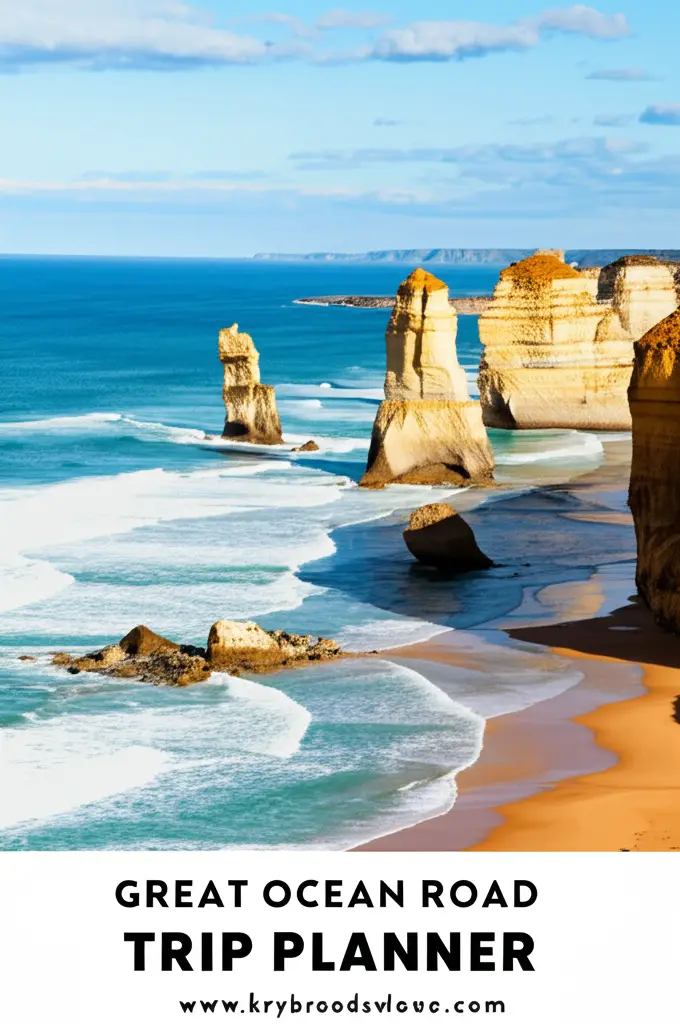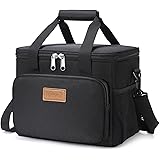The Great Ocean Road is one of the world’s most scenic coastal drives, stretching 243 kilometers (approximately 151 miles) along the stunning coastline of Victoria, Australia. From breathtaking ocean views and dramatic cliff formations to charming coastal towns and lush rainforests, the Great Ocean Road offers an unforgettable adventure for every traveler.
This comprehensive guide is your ultimate Great Ocean Road trip planner, providing everything you need to know to create the perfect itinerary and make the most of your journey.
Table of Contents
Preparing for Your Adventure
Before embarking on your Great Ocean Road adventure, it’s crucial to do some planning to ensure a smooth and enjoyable trip. This section covers essential aspects such as the best time to visit, transportation options, and pre-trip checklists.
Best Time to Visit
The best time to visit the Great Ocean Road depends on your preferences regarding weather and crowds:
- Summer (December – February): Warmest weather, ideal for swimming and beach activities. Expect larger crowds and higher accommodation prices.
- Autumn (March – May): Mild temperatures, fewer crowds than summer, and beautiful autumn foliage in the Otway Ranges.
- Winter (June – August): Coolest temperatures, increased rainfall, but fewer tourists. Opportunities for whale watching.
- Spring (September – November): Pleasant weather, blooming wildflowers, and fewer crowds compared to summer.
Consider your priorities when choosing the best time to visit. Summer is great for beach lovers, while autumn and spring offer a balance of good weather and fewer crowds. Winter can be a cozy and scenic option, especially if you’re interested in whale watching.
Transportation Options
The most popular way to experience the Great Ocean Road is by car, allowing you the flexibility to stop at various attractions and explore at your own pace. Other options include guided tours and campervan rentals.
- Self-Drive: Renting a car provides the most freedom and flexibility. Ensure you have a valid driver’s license and are familiar with Australian driving rules.
- Guided Tours: Several tour operators offer day trips or multi-day tours from Melbourne, providing a hassle-free way to see the highlights.
- Campervan/Motorhome: A popular option for those who want to combine transportation and accommodation. Campgrounds are available along the route.
Pre-Trip Checklist
Before you hit the road, make sure you have everything you need for a comfortable and safe trip:
- Accommodation Bookings: Book your accommodation in advance, especially during peak season.
- Vehicle Check: If driving your own car, ensure it’s in good condition and serviced.
- Travel Insurance: Protect yourself against unexpected events with comprehensive travel insurance.
- Packing Essentials: Pack for all types of weather, including layers, rain gear, comfortable shoes, and sunscreen.
- Navigation: Download offline maps or bring a GPS device, as mobile reception can be unreliable in some areas.
- Emergency Kit: Include a first-aid kit, flashlight, and spare tire.
Detailed Itinerary Options: Tailoring Your Trip
The Great Ocean Road can be experienced in a variety of ways, depending on the time you have available and your interests. Here are several itinerary options, ranging from a quick day trip to a more leisurely multi-day adventure.
One-Day Great Ocean Road Trip (from Melbourne)
A one-day trip is a whirlwind tour, focusing on the key highlights. Be prepared for a long day of driving and limited time at each stop.
- Morning: Depart from Melbourne early and head towards Torquay, the official start of the Great Ocean Road.
- Torquay & Bells Beach: Stop at Torquay, home to the famous Bells Beach, a renowned surfing spot. Take some photos and enjoy the coastal views.
- Anglesea: Continue to Anglesea, where you can spot kangaroos grazing on the Anglesea Golf Course.
- Lorne: Drive to Lorne, a popular seaside town. Stroll along the pier, have lunch, and enjoy the beach.
- Afternoon: Drive along the scenic coastal road towards Apollo Bay, stopping at various viewpoints along the way.
- Apollo Bay: Explore Apollo Bay, a charming town with a beautiful harbor.
- The Twelve Apostles: Continue to the Twelve Apostles. Allow ample time to explore the viewpoints and take photos.
- Loch Ard Gorge: Visit Loch Ard Gorge, a stunning coastal formation with a tragic history.
- Evening: Begin the drive back to Melbourne. Consider taking the inland route via Colac to save time.
Table: One-Day Trip Highlights
| Stop | Description | Estimated Time |
|---|---|---|
| Torquay & Bells Beach | Surfing beaches, coastal views | 30 minutes |
| Anglesea | Kangaroo spotting | 30 minutes |
| Lorne | Beach, pier, lunch | 1-2 hours |
| Apollo Bay | Harbor, town exploration | 1 hour |
| The Twelve Apostles | Iconic rock formations | 1-2 hours |
| Loch Ard Gorge | Coastal formations, history | 1 hour |
Two-Day Great Ocean Road Trip
A two-day trip allows for a more relaxed pace and the opportunity to explore more attractions along the way.
Day 1: Melbourne to Apollo Bay
- Morning: Depart from Melbourne and follow the same route as the one-day trip, stopping at Torquay, Bells Beach, Anglesea, and Lorne.
- Lunch in Lorne: Enjoy lunch at one of Lorne’s many cafes or restaurants.
- Teddy’s Lookout: Just past Lorne, stop at Teddy’s Lookout for stunning views of the coastline.
- Scenic Drive to Apollo Bay: Continue along the Great Ocean Road, enjoying the winding coastal drive.
- Afternoon: Arrive in Apollo Bay and check into your accommodation.
- Apollo Bay Exploration: Explore the town, walk along the beach, or visit the Apollo Bay Museum.
- Evening: Enjoy dinner at one of Apollo Bay’s restaurants.
Day 2: Apollo Bay to Melbourne
- Morning: Depart from Apollo Bay and head towards the Twelve Apostles.
- Great Otway National Park: Take a detour into the Great Otway National Park and visit the Cape Otway Lightstation, the oldest working lighthouse in mainland Australia.
- The Twelve Apostles: Visit the Twelve Apostles and explore the viewpoints.
- Loch Ard Gorge: Visit Loch Ard Gorge and learn about the tragic shipwreck.
- London Bridge (London Arch): Stop at London Bridge (now London Arch) for more stunning coastal views.
- Afternoon: Have lunch in Port Campbell.
- Return to Melbourne: Begin the drive back to Melbourne, either via the Great Ocean Road or the inland route.
Table: Two-Day Trip Highlights
| Day | Stop | Description | Estimated Time |
|---|---|---|---|
| 1 | Torquay & Bells Beach | Surfing beaches, coastal views | 30 minutes |
| 1 | Anglesea | Kangaroo spotting | 30 minutes |
| 1 | Lorne | Beach, pier, lunch | 2-3 hours |
| 1 | Teddy’s Lookout | Coastal views | 30 minutes |
| 1 | Apollo Bay | Town exploration, beach | 2-3 hours |
| 2 | Cape Otway Lightstation | Lighthouse, history | 2-3 hours |
| 2 | The Twelve Apostles | Iconic rock formations | 1-2 hours |
| 2 | Loch Ard Gorge | Coastal formations, history | 1 hour |
| 2 | London Bridge (London Arch) | Coastal views | 30 minutes |
Three-Day Great Ocean Road Trip
A three-day trip offers the most relaxed pace, allowing you to fully immerse yourself in the beauty of the Great Ocean Road and explore hidden gems.
Day 1: Melbourne to Lorne
- Morning: Depart from Melbourne and drive to Torquay.
- Torquay Surf Museum: Visit the Surf World Museum in Torquay to learn about the history of surfing in Australia.
- Bells Beach: Watch surfers ride the waves at Bells Beach.
- Anglesea: Spot kangaroos at the Anglesea Golf Course.
- Afternoon: Arrive in Lorne and check into your accommodation.
- Lorne Exploration: Explore Lorne, visit the beach, and have lunch.
- Erskine Falls: Take a short drive to Erskine Falls, a beautiful waterfall in the Otway Ranges.
- Evening: Enjoy dinner at one of Lorne’s restaurants.
Day 2: Lorne to Port Campbell
- Morning: Depart from Lorne and drive along the Great Ocean Road towards Apollo Bay.
- Teddy’s Lookout: Stop at Teddy’s Lookout for stunning coastal views.
- Kennett River: Stop at Kennett River to spot koalas in the wild.
- Apollo Bay: Explore Apollo Bay and have lunch.
- Great Otway National Park: Visit the Maits Rest Rainforest Walk in the Great Otway National Park.
- Cape Otway Lightstation: Visit the Cape Otway Lightstation.
- Evening: Arrive in Port Campbell and check into your accommodation. Enjoy dinner at a local restaurant.
Day 3: Port Campbell to Melbourne
- Morning: Explore the coastal attractions around Port Campbell.
- The Twelve Apostles: Visit the Twelve Apostles and enjoy the views. Consider a helicopter tour for a unique perspective.
- Loch Ard Gorge: Explore Loch Ard Gorge and learn about the history of the Loch Ard shipwreck.
- London Bridge (London Arch): Visit London Bridge (London Arch).
- The Grotto: Stop at The Grotto, a unique coastal rock formation.
- Afternoon: Have lunch in Port Campbell.
- Peterborough: Visit the small coastal town of Peterborough.
- Return to Melbourne: Begin the drive back to Melbourne, taking the inland route via Colac.
Table: Three-Day Trip Highlights
| Day | Stop | Description | Estimated Time |
|---|---|---|---|
| 1 | Torquay Surf Museum | History of surfing | 1-2 hours |
| 1 | Bells Beach | Surfing beaches, coastal views | 30 minutes |
| 1 | Anglesea | Kangaroo spotting | 30 minutes |
| 1 | Lorne | Town exploration, beach | 2-3 hours |
| 1 | Erskine Falls | Waterfall | 1-2 hours |
| 2 | Teddy’s Lookout | Coastal views | 30 minutes |
| 2 | Kennett River | Koala spotting | 1-2 hours |
| 2 | Apollo Bay | Town exploration, beach | 2-3 hours |
| 2 | Maits Rest Rainforest Walk | Rainforest walk | 1 hour |
| 2 | Cape Otway Lightstation | Lighthouse, history | 2-3 hours |
| 3 | The Twelve Apostles | Iconic rock formations | 1-2 hours |
| 3 | Loch Ard Gorge | Coastal formations, history | 1 hour |
| 3 | London Bridge (London Arch) | Coastal views | 30 minutes |
| 3 | The Grotto | Coastal rock formation | 30 minutes |
| 3 | Peterborough | Coastal town | 1 hour |
Must-See Attractions Along the Great Ocean Road
The Great Ocean Road is packed with incredible sights and experiences. Here’s a guide to some of the most popular attractions:
Bells Beach
Located near Torquay, Bells Beach is one of Australia’s most famous surfing beaches. It hosts the Rip Curl Pro surfing competition annually and offers stunning coastal views even if you’re not a surfer.
Anglesea
Anglesea is a charming coastal town known for its beautiful beaches and, most famously, its kangaroos grazing on the Anglesea Golf Course. It’s a unique and memorable sight.
Lorne
Lorne is a popular seaside town with a vibrant atmosphere. It features a beautiful beach, a bustling pier, and numerous cafes, restaurants, and shops. Teddy’s Lookout, located just past Lorne, offers panoramic views of the coastline.
Read More: Can You Bring Champagne On A Plane? Everything You Need To Know!
Kennett River
Kennett River is a small settlement known for its koala population. Stop along Grey River Road and look up into the eucalyptus trees to spot these adorable creatures in their natural habitat.
Apollo Bay
Apollo Bay is a picturesque coastal town with a sheltered harbor and a relaxed vibe. It’s a great place to stop for lunch, explore the town, and enjoy the beach.
Great Otway National Park
The Great Otway National Park offers a contrast to the coastal scenery, with lush rainforests, waterfalls, and hiking trails. The Cape Otway Lightstation, the Maits Rest Rainforest Walk, and Erskine Falls are popular attractions within the park.
Cape Otway Lightstation
The Cape Otway Lightstation is the oldest working lighthouse in mainland Australia. It offers stunning views of the coastline and the Bass Strait and provides insights into the region’s maritime history.
The Twelve Apostles
The Twelve Apostles are the most iconic attraction along the Great Ocean Road. These limestone stacks rising from the Southern Ocean are a breathtaking sight. Various viewpoints offer different perspectives, and a helicopter tour provides a unique aerial view.
Loch Ard Gorge
Loch Ard Gorge is a stunning coastal formation with dramatic cliffs and a sandy beach. It’s also the site of the tragic Loch Ard shipwreck in 1878. Learn about the history of the shipwreck and explore the beautiful scenery.
London Bridge (London Arch)
London Bridge, now known as London Arch after a section collapsed in 1990, is another impressive coastal formation. It offers stunning views of the ocean and the surrounding coastline.
The Grotto
The Grotto is a unique coastal rock formation with a sinkhole and a cave. It provides a different perspective of the ocean and is a popular spot for photographers.
Accommodation Options Along the Great Ocean Road
Finding the right accommodation is crucial for a comfortable and enjoyable Great Ocean Road trip. Here are some options to consider, ranging from budget-friendly campsites to luxurious hotels.
Camping and Caravan Parks
Camping is a popular and affordable option, especially for those traveling with a campervan or tent. Many caravan parks along the Great Ocean Road offer powered sites, amenities, and stunning locations.
- Bells Beach Caravan Park (Torquay): Located near Bells Beach, offering powered and unpowered sites.
- Anglesea Family Caravan Park: Close to the Anglesea River and beach, with a range of facilities.
- Lorne Foreshore Caravan Park: Situated right on the beach in Lorne, offering stunning ocean views.
- Apollo Bay Recreation Reserve: Located in Apollo Bay, with easy access to the beach and town.
- Princetown Recreation Reserve: Close to the Twelve Apostles, offering a convenient base for exploring the area.
Budget Hotels and Motels
Budget hotels and motels provide comfortable and affordable accommodation options. They are often located in the main towns along the Great Ocean Road.
- Great Ocean Road Resort (Anglesea): Offers comfortable rooms and apartments at a reasonable price.
- Lorne Hotel: A historic hotel in the heart of Lorne, with budget-friendly rooms.
- Apollo Bay Waterfront Motor Inn: Offers comfortable rooms with ocean views in Apollo Bay.
- Port Campbell Motor Inn: Provides clean and comfortable rooms in Port Campbell, close to the Twelve Apostles.
Mid-Range Hotels and Apartments
Mid-range hotels and apartments offer a balance of comfort and affordability, with amenities such as swimming pools, restaurants, and spacious rooms.
- Cumberland Lorne Resort: Offers a range of apartments with ocean views and resort facilities.
- Mantra Lorne: A historic resort in Lorne, with a range of accommodation options and facilities.
- Chris’s Beacon Point (Apollo Bay): Offers stylish apartments with stunning ocean views.
- Southern Ocean Villas (Port Campbell): Provides spacious villas with ocean views and modern amenities.
Luxury Hotels and Resorts
For a luxurious experience, consider staying at one of the upscale hotels and resorts along the Great Ocean Road. These properties offer exceptional service, stunning locations, and premium amenities.
- Qii House (Lorne): A boutique hotel with stylish rooms and stunning ocean views.
- The Anchorage (Apollo Bay): A luxurious resort with a range of accommodation options and premium facilities.
Tips for Driving the Great Ocean Road
Driving the Great Ocean Road is an adventure in itself. Here are some tips to ensure a safe and enjoyable journey:
- Drive on the Left: Remember that in Australia, you drive on the left side of the road.
- Watch for Wildlife: Be aware of kangaroos, wallabies, and other wildlife, especially at dawn and dusk.
- Take Breaks: The Great Ocean Road is a long drive, so take regular breaks to avoid fatigue.
- Check Weather Conditions: Weather can change quickly, so check the forecast before you set out.
- Fuel Up: Fuel stations are limited in some areas, so fill up when you have the chance.
- Drive Carefully on Winding Roads: The Great Ocean Road is known for its winding roads and hairpin turns, so drive carefully and stay within the speed limit.
- Respect Local Laws: Adhere to speed limits and parking regulations.
- Be Prepared for Limited Mobile Reception: Mobile phone reception can be unreliable in some areas, so download offline maps or bring a GPS device.
Activities Beyond the Road: Exploring Further
While the Great Ocean Road itself is the main attraction, there are many opportunities to explore beyond the road and discover hidden gems.
Hiking in the Otway Ranges
The Great Otway National Park offers numerous hiking trails, ranging from short walks to multi-day treks. Explore lush rainforests, waterfalls, and scenic lookouts.
Whale Watching
During the winter months (June to August), southern right whales migrate to the waters off the Great Ocean Road to breed. Several locations offer excellent whale-watching opportunities, including Logans Beach in Warrnambool and Cape Otway.
Surfing
The Great Ocean Road is a surfer’s paradise, with numerous surf breaks to suit all skill levels. Bells Beach is the most famous, but other popular spots include Torquay, Anglesea, and Johanna Beach.
Wine Tasting
The Geelong and Bellarine Peninsula regions, located near the start of the Great Ocean Road, are known for their wineries. Take a detour and enjoy wine tasting at some of the local vineyards.
Food and Drink Experiences
The Great Ocean Road region is home to a variety of local producers, offering opportunities to sample fresh seafood, local cheeses, and gourmet treats. Visit farmers’ markets, farm gates, and restaurants to experience the region’s culinary delights.
Photography Tips for the Great Ocean Road
The Great Ocean Road is a photographer’s dream, with stunning landscapes and dramatic coastal scenery. Here are some tips to capture the best shots:
- Golden Hour: The best time to photograph the Great Ocean Road is during the golden hours (shortly after sunrise and before sunset) when the light is soft and warm.
- Composition: Use leading lines, such as the road or the coastline, to draw the viewer’s eye into the scene.
- Wide-Angle Lens: A wide-angle lens is ideal for capturing the vastness of the landscape.
- Telephoto Lens: A telephoto lens can be useful for capturing details, such as the Twelve Apostles from a distance.
- Filters: Use a polarizing filter to reduce glare and enhance colors.
- Tripod: A tripod is essential for capturing sharp images in low light or when using slow shutter speeds.
- Explore Different Perspectives: Don’t just shoot from the main viewpoints. Explore different angles and perspectives to capture unique shots.
- Capture the Details: Don’t just focus on the big picture. Capture the details, such as the texture of the rocks, the waves crashing on the shore, or the wildflowers blooming along the roadside.
Budgeting for Your Great Ocean Road Trip
The cost of a Great Ocean Road trip can vary depending on your travel style and preferences. Here’s a breakdown of potential expenses:
- Transportation: Car rental, fuel, parking fees, or tour costs.
- Accommodation: Camping fees, hotel or motel costs, or vacation rental expenses.
- Food and Drink: Restaurant meals, groceries, snacks, and drinks.
- Activities: Entrance fees to attractions, tours, and activities.
- Miscellaneous: Souvenirs, travel insurance, and other incidental expenses.
To save money, consider camping, cooking your own meals, and traveling during the off-season. Look for free activities, such as hiking and exploring the beaches.
Safety Considerations on the Great Ocean Road
Safety should be a top priority on your Great Ocean Road trip. Here are some important considerations:
- Driving Safety: Drive carefully on the winding roads and be aware of wildlife. Take regular breaks to avoid fatigue.
- Weather Conditions: Check the weather forecast before you set out and be prepared for changing conditions.
- Water Safety: Swim only at patrolled beaches and be aware of rip currents.
- Hiking Safety: Wear appropriate footwear and clothing when hiking, and stay on marked trails.
- Emergency Contacts: Save emergency contact numbers in your phone and know where to find the nearest medical facilities.
- First Aid Kit: Carry a first aid kit with essential supplies.
- Inform Someone of Your Plans: Let someone know your itinerary and expected return time.
Read More: Travel Queries: Can I Take Shaving Cream In My Carry-On?
Great Ocean Road Trip Planner: FAQ Section
Frequently Asked Questions
It takes approximately 9 to 10 hours to drive the entire Great Ocean Road without stopping. However, it’s recommended to spend at least 2-3 days to fully experience the attractions and enjoy a relaxed pace.
The best time to visit depends on your preferences. Summer (December-February) offers warm weather, ideal for beaches, but expect crowds. Autumn (March-May) and Spring (September-November) offer mild weather and fewer crowds. Winter (June-August) can be cooler with rain but offers opportunities for whale watching.
No, a 4WD is not necessary to drive the Great Ocean Road. The road is well-maintained and suitable for standard cars. However, if you plan to explore unsealed roads or beaches, a 4WD may be beneficial.
Yes, there are gas stations in the major towns along the Great Ocean Road, such as Torquay, Lorne, Apollo Bay, and Port Campbell. However, it’s advisable to fill up whenever you have the chance, as gas stations can be spaced out in some areas.
Mobile phone reception can be unreliable in some areas along the Great Ocean Road, particularly in the Otway Ranges and remote coastal sections. It’s a good idea to download offline maps or bring a GPS device.
Yes, there are restrooms and facilities at the major attractions and towns along the Great Ocean Road. However, it’s a good idea to plan your stops accordingly, as facilities can be limited in some areas.
Yes, you can see kangaroos at the Anglesea Golf Course and koalas at Kennett River. Keep an eye out for wildlife along the roadside, especially at dawn and dusk.
Public transportation along the Great Ocean Road is limited. V/Line buses operate between some of the major towns, but they may not stop at all of the attractions. Guided tours are a good option if you don’t want to drive yourself.
Yes, there are plenty of restaurants and cafes in the major towns along the Great Ocean Road, offering a range of cuisines and dining options. However, it’s a good idea to check the opening hours, especially during the off-season.
Pack for all types of weather, including layers, rain gear, comfortable shoes, sunscreen, a hat, and sunglasses. Also, bring a first-aid kit, a flashlight, and a camera to capture the stunning scenery.
Most of the natural attractions along the Great Ocean Road, such as the Twelve Apostles and Loch Ard Gorge, are free to visit. However, there may be entrance fees for some attractions, such as the Cape Otway Lightstation.
Yes, you can swim at the beaches along the Great Ocean Road, but it’s important to swim only at patrolled beaches and be aware of rip currents. Popular swimming beaches include Torquay, Lorne, and Apollo Bay.
Conclusion: Embrace the Great Ocean Road Adventure
The Great Ocean Road is more than just a scenic drive; it’s an unforgettable journey that immerses you in the natural beauty and rich history of Victoria, Australia. With its dramatic coastline, charming towns, and diverse attractions, the Great Ocean Road offers something for every traveler. From the iconic Twelve Apostles to the lush rainforests of the Otway Ranges, every turn reveals a new and breathtaking vista.
Planning your Great Ocean Road trip is key to maximizing your experience. Whether you choose a whirlwind day trip or a leisurely multi-day adventure, this comprehensive guide provides the tools and information you need to create the perfect itinerary. Consider the best time to visit based on your preferences for weather and crowds, and choose the transportation option that suits your style, whether it’s a self-drive adventure, a guided tour, or a campervan experience.






